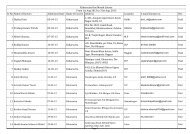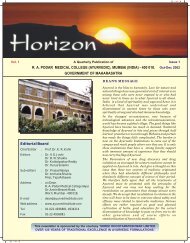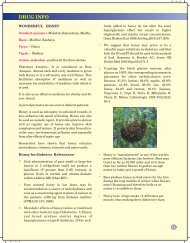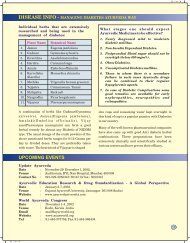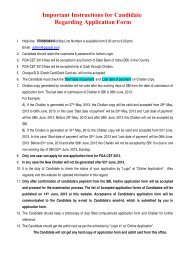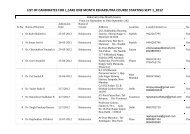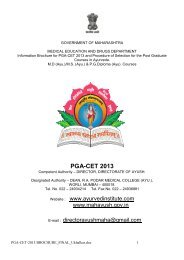Prameha in terms of Diabetes Mellitus, Metabolic syndrome and ...
Prameha in terms of Diabetes Mellitus, Metabolic syndrome and ...
Prameha in terms of Diabetes Mellitus, Metabolic syndrome and ...
- No tags were found...
You also want an ePaper? Increase the reach of your titles
YUMPU automatically turns print PDFs into web optimized ePapers that Google loves.
PRAMEHA IN AYURVEDA, PART 2 591<strong>and</strong> triglycerides.40 In rats with diabetes, it displayed immunomodulatbry<strong>and</strong> neuroprotective actions,41 reducedoxidative stress,42 <strong>and</strong> showed a significant effect on keycarbohydrate metabolic enzymes.4"1 Garlic lowered fast<strong>in</strong>gblood glucose <strong>and</strong> serum triglyceride levels <strong>in</strong> a double-bl<strong>in</strong>dplacebo-controlled study on patients with type 2 diabetes.44In rats with streptozotoc<strong>in</strong>-<strong>in</strong>duced diabetes, it significantlydecreased serum glucose, total cholesterol, <strong>and</strong> triglycerides.The antidiabetic effect was greater than that <strong>of</strong> glibenclamide.'15Garlic significantly decreased total cholesterol<strong>and</strong> LDL, <strong>and</strong> significantly raised HDL, <strong>in</strong> a r<strong>and</strong>omized,double-bl<strong>in</strong>d, placebo-controlled study on male patients withmild hypercholesterolemia.116 Similar results were seen <strong>in</strong> astudy.'on patients wittvcoronary artery disease, hi whichgarlic significantly reduced total serum cholesterol arid tri-'"glyceridiis, <strong>and</strong> significantly <strong>in</strong>creased HDL/1'Vegetables'that mitigate Pramehn <strong>in</strong>clude Kiiraveflaki (Momoniiaicharantia L<strong>in</strong>n.; bitter gourd; bitter melon) <strong>and</strong> Paloh(Trichcsp.nthes artgu<strong>in</strong>a L<strong>in</strong>n.). M. dwrnntia adm<strong>in</strong>istered orallyproduced a significant hvpoglyccmic effect <strong>in</strong> rabbits with alloxan-<strong>in</strong>duceddiabetes.45 In rats with aHoxan-<strong>in</strong>duced diabetessubjected to a chronic sucrose load, M. clmrantia ma<strong>in</strong>ta<strong>in</strong>ednormal glucose levels, reduced triglyceridc <strong>and</strong> LDL levels,<strong>and</strong> <strong>in</strong>creased @ HDL levels. It also improved the antioxidantstatus, as evidenced by low levels <strong>of</strong> thiobarbituric acidreactivesubstances <strong>and</strong> normal levels <strong>of</strong> reduced glutathionc.Upon term<strong>in</strong>ation <strong>of</strong> the treatment, the rats were underoxidative stress <strong>and</strong> reverted back to diabetic conditions.49Feed<strong>in</strong>g dried bitter gourd powder to rats with streptozotoc<strong>in</strong><strong>in</strong>duceddiabetes decreased fast<strong>in</strong>g blood glucose by nearly30%.5D An aqueous extract powder reduced fast<strong>in</strong>g bloodglucose <strong>in</strong> rats with diabetes by 48%, an effect comparable tothat <strong>of</strong> glibenclarnide.''1 A methanol extract <strong>of</strong> bitter gourdnormalized blood glucose, reduced triglycerides <strong>and</strong> LDL, <strong>and</strong><strong>in</strong>creased KDL <strong>in</strong> rats with diabetes. Discont<strong>in</strong>uation <strong>of</strong> theextract resulted <strong>in</strong> reversion to n diabetic stated2 Ai/uiivJa advocates us<strong>in</strong>g Tikia Shake?''' (green ieafy vegetables) as a ma<strong>in</strong>component <strong>of</strong> the diet for patieiits with Pramelui. Judiciousadm<strong>in</strong>istration <strong>of</strong> legumes <strong>and</strong> gra<strong>in</strong>s such as Kodmva {kodomillet), Mudga (green gram, moong dal), Kulctha (Macrolylomauniflqrum L<strong>in</strong>n., horse gram), Adhaki Beeja (pigeon peas, tcor@dril), <strong>and</strong> so orr may be helpful. Oils such as Sarshapa Tail/i*4(mustard oil) <strong>and</strong> Ingiidi [Bnlanites asgypt<strong>in</strong>ca (L<strong>in</strong>n.) Del.] can beused to prevent any further <strong>in</strong>crease <strong>in</strong> lipicl levels.Ayurveda does not prohibit meat <strong>in</strong> .the diet <strong>of</strong> Pramclwpatients; however, fry<strong>in</strong>g <strong>of</strong> the meat is not recommended."Harlna (venison) <strong>and</strong> Shashakn (rabbit) are the recommendedmeats for Pramehn patients. The meat <strong>of</strong> domesticated animals is not recommended, <strong>and</strong> tliis correlates with currentresearch f<strong>in</strong>d<strong>in</strong>gs. Consumption <strong>of</strong> red meat <strong>and</strong> processedmeats are associated with an <strong>in</strong>creased risk <strong>of</strong> diabetes <strong>in</strong>women.^5""57 Frequent consumption <strong>of</strong> processed meat hasbeen associated with an <strong>in</strong>creased risk <strong>of</strong> diabetes <strong>in</strong> men.58A systematic review <strong>and</strong> meta-analysis oi studies on red <strong>and</strong>processed meats concluded that the consumption <strong>of</strong> processed meats is associated with a higher <strong>in</strong>cidence <strong>of</strong> coronary heart disease <strong>and</strong> diabetes mellitus.59Ushnam Aiweeynt refers to eat<strong>in</strong>g a diet mat is warm. Thisis recommended s<strong>in</strong>ce it will ease Krtpha, normalize Va<strong>in</strong>, <strong>and</strong>stimulate Pitta to <strong>in</strong>tensify the power <strong>of</strong> digestion. However,food that is. extremely hot should n.o.t be. eaten. Leftovers orold food that is reheated should also not be eaten.Ayurveda recommends the use <strong>of</strong> Amtpana (an adjuvant)along with the dier <strong>and</strong> any herbs that are be<strong>in</strong>g utilized. Inaddition to the action <strong>of</strong> disease correction, the adjuvant actsas a carrier to transport the therapeutic phytochemicals <strong>in</strong>tothe system, <strong>and</strong> may even act as a catalyst <strong>in</strong> the <strong>in</strong>teraction<strong>of</strong> the various phylochemicals. Sarodaka <strong>and</strong> Kushodcka aredr<strong>in</strong>ks that can be employed <strong>in</strong> this regard.3 Sarodaka is waterprepared from Khndira [Acticia catechu (L<strong>in</strong>n, f.) Willd.] thathas been boiled, then cooled down. Kushodnka is water prepared from Kusha [Destnostachyn bipiimata (L<strong>in</strong>n.) Stapfj thathas been boiled, then cooled. These dr<strong>in</strong>ks can be taken withmeals, with herbs, cr whenever the patient feels thirst. Theyare particularly helpful for obese <strong>in</strong>dividuals who are suffer<strong>in</strong>g from <strong>Prameha</strong>, s<strong>in</strong>ce they weaken both Kapha <strong>and</strong>Meda. Another recommended dr<strong>in</strong>k is called Raga. It isusually prepared from, small- sour fruit." such as Ajn':;'aki,Knpuha5* {Fcrouia l<strong>in</strong>onhi (L<strong>in</strong>n.) Sw<strong>in</strong>g1.;.1!, Jr.nibu {Syzygiv.nicumird '(L<strong>in</strong>n.) Skecls], ru\ so cL\>!o'.:j with a modestamount <strong>of</strong> sr.lt."How much you eat." Another consideration <strong>in</strong> tiis dietetic regulations is "how much you eat." The recommendation <strong>in</strong> this regard is Matnwat Asneeyr.t, which means tlvjfood should' be eaten <strong>in</strong> due measure:1 The quantity <strong>of</strong> foodthat is appropriate is not the same, for everyone. It variesaccord<strong>in</strong>g to the <strong>in</strong>dividual's psychophysiologic constitution<strong>and</strong> Agni (digestive <strong>and</strong> metabolic process). The. idealamount <strong>of</strong> food is determ<strong>in</strong>ed by the <strong>in</strong>dividual's level <strong>of</strong>satiety. Gum Aaluira (foods with a heavy quality) should beeaten to half <strong>of</strong> one's satiety level, whereas Laghit Aaham(foods with a light quality) can be eaten until the <strong>in</strong>dividualread^s Adi satiety.* With regard to optimal digestion <strong>of</strong> ameal, one can visualize the stomach as be<strong>in</strong>g divided <strong>in</strong>tothree parts: One third should be filled with solid food, l -*third with 1 ^ id 1 r \ A n d rcn it t rjallow for tl ur j, \ \ r cF il rs n he d ^process.3 The prjtt <strong>in</strong>cj.it <strong>of</strong>f 1 o the udiv 1 <strong>in</strong>ot produce undu p ro t tH torn ai v ill not le it<strong>in</strong> discomfort dur<strong>in</strong>g activities such as wait<strong>in</strong>g, st<strong>and</strong><strong>in</strong>g,sleep<strong>in</strong>g, talk<strong>in</strong>g, <strong>and</strong> so on; <strong>and</strong> will satisfy .the <strong>in</strong>dividual'shunger <strong>and</strong> thirst. .Eat<strong>in</strong>g-an excessive.amount <strong>of</strong> food,-mayprovoke all ihe.Dcrhas, <strong>and</strong>-.catiiig.,^.<strong>in</strong>sufficient amountwill uiipairi the@ ";.:;'ijrrjij^i <strong>of</strong>-i'.ifi.D.vs^a (trw fundamental ,pr<strong>in</strong>ciples th;.t enppoit the various bodily Cs5i".cs)."When you eat." @ For optimal digestion, it .is important toconsider,"when you eat.'.' Jeerne. Asneeyai refers to the recommendation that one should eat only after the previousmeal has been fully digested. Untimely <strong>in</strong>gestion <strong>and</strong> overeat<strong>in</strong>g leads to accumulation <strong>of</strong>.the Doshns <strong>and</strong> overwhelmsAgni (the digestive power), which contributes to the development <strong>of</strong> Apnthyan'mnttaja (acquired) <strong>Prameha</strong>. Digestion <strong>of</strong>the previous meal can b



